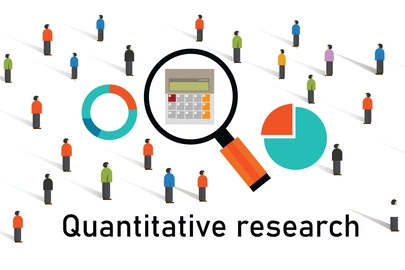What are the strengths of quantitative research?
The nature of business research underscores the indispensable role of consistent market research for brands striving to offer products or services that resonate with their audience. Effective and strategic market research forms the cornerstone of aligning a brand with its audience, ensuring a symbiotic relationship. Staying attuned to current market trends and evolving audience preferences is imperative for making informed decisions and crafting impactful marketing or business strategies. Market research, in essence, encompasses two distinct yet complementary types: quantitative research and qualitative research. Quantitative research, undertaken by specialized quantitative research companies, involves the collection and analysis of numerical data, often structured and amenable to statistical methods. This method, characterized by its structured approach, allows for the inclusion of a larger number of respondents, contributing to statistically robust findings. One of the strengths of quantitative research lies in its ability to provide a comprehensive and quantifiable understanding of market dynamics. The strengths of quantitative research lie in its ability to distill complex data into manageable patterns and trends. This aids in forecasting market behavior and informing strategic decision-making.
Comparative Analysis : Quantitative vs. Qualitative Research
Research methodologies play a pivotal role in extracting meaningful insights from data, and two prominent approaches, quantitative and qualitative research, cater to distinct dimensions of investigation. Let us conduct a comparative analysis of both methodologies.
Quantitative Research : Characteristics
Quantitative research is characterized by its emphasis on numerical data and statistical analysis. It employs structured methodologies, such as surveys and experiments, to gather measurable and quantifiable data.
Applications
Widely used in fields like economics, psychology, and market research, quantitative research is effective in examining patterns, correlations, and statistical relationships. It aims to generalize findings to a larger population.
Strengths
- Statistical Validity : Provides statistically valid and reliable results.
- Generalization : Allows for the generalization of findings to broader populations.
- Objectivity : Minimizes researcher bias through structured data collection and analysis.
Qualitative Research : Characteristics
Qualitative research is characterized by its exploratory nature, focusing on in-depth understanding and interpretation. It employs unstructured methodologies, such as interviews and focus groups, to collect non-numerical data.
Applications
Commonly used in social sciences, anthropology, and market research, qualitative research seeks to uncover underlying motivations, attitudes, and behaviors. It often involves smaller sample sizes to facilitate deeper exploration.
Strengths
- Rich Insights : Provides rich, detailed insights into complex phenomena.
- Flexibility : Allows for adaptability during the research process.
- Contextual Understanding : Offers a nuanced understanding of social and cultural contexts.
Choosing the Right Approach
Here are the considerations to take into account when deciding between these two research methodologies:
- Research Questions : Quantitative for measurable data, qualitative for exploratory insights.
- Sample Size : Larger samples for quantitative, smaller for qualitative.
- Data Collection Methods : Surveys and experiments are used for quantitative, while interviews and observations are deployed for qualitative research.
Many researchers find value in combining both approaches (mixed methods) to harness the strengths of each methodology, providing a comprehensive and nuanced understanding of the research topic. The ultimate choice between quantitative and qualitative research hinges on your research goals, the nature of the phenomenon under study, and the depth of understanding sought. While qualitative research offers a contextual exploration, quantitative research excels in statistical validation. Let us explore the strengths of quantitative research in the subsequent sections.
Understanding Quantitative Research and Its Value
Quantitative market research revolves around using statistical, computational, and mathematical techniques to analyze numerical data and derive valuable insights and patterns. By collecting data through quantitative methods, quantitative research companies can help quantify consumer preferences, behaviors, and opinions. This data can then be subjected to statistical analysis, enabling researchers to identify correlations, trends, and patterns that may not be immediately apparent. For instance, quantitative market research can help businesses understand the impact of price changes on consumer purchasing behavior. By collecting data on prices and corresponding sales figures, researchers can analyze the relationship between price and demand, allowing businesses to make informed pricing decisions. Quantitative research allows businesses to identify target markets, evaluate product features, and measure the impact of marketing campaigns with a higher degree of precision. Let us now discuss in detail the various strengths of quantitative market research that make it a valuable research tool:
Objectivity and Reproducibility
One of the key strengths of quantitative research lies in its objective nature. By employing standardized methods of data collection and analysis, quantitative research minimizes bias and subjectivity. This objectivity enhances the reproducibility of findings, allowing other researchers to replicate the study and verify its results. This characteristic makes quantitative research highly reliable and trustworthy.
Statistical Rigor
Quantitative research relies on statistical tools and techniques to analyze data. These statistical methods enable researchers to identify patterns, relationships, and correlations within the data. By employing statistical rigor, quantitative research provides a solid foundation for making generalizations about larger populations. It allows researchers to draw accurate conclusions and make informed decisions based on the evidence provided by the data.
Generalizability
Thanks to its focus on large sample sizes, quantitative research has the potential for greater generalizability than other methods. By studying a representative sample, researchers can make inferences about a larger population. This capacity for generalization is particularly valuable in fields such as psychology, sociology, and market research, where insights from a limited sample can be applied to a broader target audience or population.
Objective Measurement
Quantitative research often involves the use of standardized instruments and measurements, ensuring consistent data collection across different settings and researchers. This objectivity in measurement reduces the potential for interpretation bias and enhances the reliability of the research findings. Researchers can quantify variables, assess relationships, and draw conclusions based on measurable data, adding credibility to their research outcomes.
Data-Driven Decision-Making
In today's data-driven world, quantitative research plays a vital role in informing decision-making across various domains. Governments, businesses, healthcare institutions, and policymakers rely on quantitative research to gather insights, evaluate the effectiveness of interventions, and guide strategic planning. The ability to collect and analyze large volumes of numerical data efficiently allows stakeholders to make evidence-based decisions and improve outcomes.
How Data Analysis and Visualization Can Help Businesses Overcome Unforeseen Challenges?
When faced with unexpected situations or disruptions, businesses can turn to their data to understand patterns, trends, and potential solutions. Data analysis allows for the identification of key variables and their relationships, enabling businesses to uncover hidden opportunities or risks. By applying statistical techniques and computational models, businesses can analyze large volumes of data efficiently and extract actionable insights. Visualization techniques, such as charts, graphs, and dashboards, further enhance the understanding of complex data sets, making it easier to communicate findings and facilitate data-driven discussions. The combination of data analysis and visualization empowers businesses to make agile and informed decisions, adapt their strategies, and navigate through unforeseen challenges with confidence.
How Quantitative Research Allows For Efficient Data Collection And Analysis On A Large Scale?
Quantitative research is highly advantageous when it comes to large scale data collection and analysis. It allows researchers to collect data from a substantial sample size, which enhances the representativeness of the findings. Surveys, experiments, and other quantitative methods enable researchers to gather data efficiently from many participants, saving time and resources. Moreover, quantitative research employs statistical tools and computational techniques to analyze the collected data swiftly and systematically. This enables researchers to identify patterns, correlations, and trends within the data, providing valuable insights at scale. The ability to process large volumes of numerical data efficiently allows for robust statistical analyzes, making quantitative research an indispensable methodology for conducting comprehensive studies and generating meaningful results.
Applications of Quantitative Research in Different Industries
The strengths of quantitative research are instrumental across diverse industries, providing a systematic and structured approach to derive actionable insights and contribute to advancements within each sector. The application of quantitative research methodologies yields valuable insights, informs strategic decision-making, and contributes to the advancement of knowledge within distinct sectors. Let's explore how quantitative research finds relevance and utility in different industries.
Healthcare Industry
In the healthcare industry, quantitative research plays a crucial role in assessing the efficacy of treatments, understanding patient outcomes, and evaluating the impact of healthcare interventions. Large-scale surveys, clinical trials, and statistical analysis of health-related data contribute to evidence-based practices and inform healthcare policy, showcasing the strengths of quantitative research in providing robust and measurable insights.
Marketing and Consumer Behavior
Quantitative research is extensively utilized in marketing to measure consumer preferences, gauge the effectiveness of advertising campaigns, and analyze market trends. Surveys, experiments, and data analytics provide marketers with quantifiable insights, enabling them to tailor strategies that resonate with target audiences. The nature of business research in marketing relies on the strengths of quantitative research for its ability to provide statistically significant data.
Financial Services
When it comes to the financial sector, quantitative research is fundamental for risk management, investment analysis, and portfolio optimization. Through the use of statistical models and data analysis, financial analysts make informed predictions, assess market trends, and develop strategies to maximize returns and minimize risks. The strengths of quantitative research are particularly evident in the financial industry's reliance on precise and quantifiable data.
Education and Academia
Quantitative research is prevalent in educational research, where it aids in assessing the impact of teaching methods, evaluating educational programs, and measuring student performance. Surveys, standardized testing, and statistical analyses contribute to evidence-based improvements in educational practices.
Technology and Innovation
Quantitative research guides product development, user experience design, and market analysis. Metrics such as user engagement, adoption rates, and performance analytics are crucial in shaping technological advancements and optimizing products and services. Different types of quantitative market research methods are employed in the tech sector to make sense of quantifiable data in order to drive innovation and strategic decision-making.
Challenges and Limitations of Quantitative Research And How To Overcome Them
Quantitative research, while a powerful methodology for deriving numerical insights, is not without its challenges and limitations. Recognizing and addressing these obstacles is essential for ensuring the validity and reliability of research findings. Let's explore the common challenges associated with quantitative research and strategies to overcome them.
Sampling Bias and Representation
Challenge : One of the primary challenges is the potential for sampling bias, where the selected sample may not accurately represent the entire population.
Overcoming Strategy : Employ random sampling techniques to ensure every member of the population has an equal chance of being included. Additionally, stratified sampling can be utilized to ensure representation across different subgroups.
Measurement Issues
Challenge : Issues related to the measurement instrument, such as unclear survey questions or biased scales, can compromise the quality of data.
Overcoming Strategy : Conduct pilot studies to test and refine measurement instruments. Ensure survey questions are clear, concise, and free from potential biases. Utilize validated measurement tools whenever possible.
Ethical Considerations
Challenge : Ethical issues, such as privacy concerns or unintended harm to participants, must be carefully navigated in quantitative research.
Overcoming Strategy : Ensure research protocols adhere to ethical guidelines. Obtain informed consent from participants, anonymize data to protect privacy, and conduct thorough ethical reviews before initiating the research.
Resource Intensiveness
Challenge : Quantitative research can be resource-intensive in terms of time, costs, and manpower.
Overcoming Strategy : Carefully plan and budget for research resources. Leverage technological tools for data collection and analysis to streamline processes. Consider collaborations to pool resources and expertise. Hiring a market research company can get the job done for you without the necessary overheads.
Final Word
As can be seen, quantitative market research methods bring a lot of advantages to the table. If you want to build your business empire on the foundation of data, quantitative descriptive research is the method to choose. By harnessing the power of quantitative research, businesses can unlock valuable insights, gain a competitive edge, and make informed decisions based on robust evidence. In this regard, it is of utmost importance to pick a reliable quantitative research firm that can assist you at every stage of your research and data collection process. If you are looking for the top market research companies or a global market research agency with unmatched experience, look no further than Unimrkt Research. As one of the top quantitative market research companies in India, we offer a plethora of services, including quantitative, qualitative, and paid market research. We have worked in more than 22 languages while being ISO20252 and ISO 27001 certified. To learn more about our services, contact us at +91-124-424-5210, email us at sales@unimrkt.com, or fill out our contact form, and we will get back to you shortly.
Quick Enquiry
Customer Service, We Make it Better
Recent Posts
- How to Clarify and Align Your Research Goals for Maximum Impact
- Mining Valuable Data: The Driving Force for an Effective Growth Marketing Strategy
- Speaking the Customers Language: 7 Tips for Meaningful Qualitative Research
- Creating Value for Investors: The Benefits of Primary Market Research
- Utilizing Closed-Ended Questions For Quantitative Market Research
- Capturing the Changing Interests of Millennials Through Qualitative Research
- Refining Unit Economics with Robust Quantitative Market Research
- A Concise Guide to Quantitative Market Research
- 3 B2B Market Research Trends That Could Shape 2024
- Eyes on 2024: Changes That Might Disrupt the Healthcare Industry This Year
- Cracking the Language to Make Survey Questions Inclusive in 2024
- Attracting Investors: How Market Research Can Solidify Your Case
- Solid Foundations: Ways to Enhance Trustworthiness in Qualitative Research
- What Makes CATI Research So Effective?
- Moderator Qualities That Improve Qualitative Market Research
- 5 Consumer Market Trends That Will Define 2024
- What are the strengths of quantitative research?
- How to Make Your Partnership with Primary Market Research Firms Fruitful
- A Quick Guide to Harnessing the Strengths of Quantitative Research
- Advice from Your Research Partner: Don't Compromise Quality on Online Surveys













